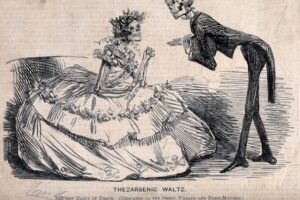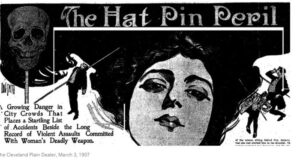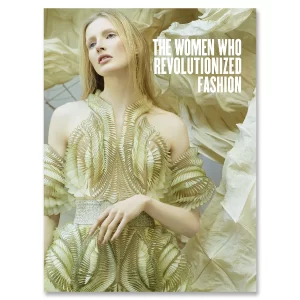Love and Death at Salem’s PEM
Petra Slinkard is the Peabody Essex Museum’s Director of Curatorial Affairs and the Nancy B. Putnam Curator of Fashion and Textiles. Welcome Petra.
Nancy Gardner: Unfortunately, I wasn’t unable to attend your Halloween season presentation—Dark Glamour. It sounded fascinating—especially for mystery writers. Tell us a bit about it.

Petra Slinkard: My goal was to highlight works in the museum’s collection while calling attention to fashion’s sometimes dangerous side.
For instance, the term “mad as a hatter” came from the use of mercury in the making of men’s hats starting in the mid-17th century and continuing up to the 1940s. Because of the practice, mercury poisoning became endemic among felt workers.
And in another instance, a 16th century skin whitener contained white lead and often resulted in lead poisoning and hair loss. In one notable case, it resulted in the death of an 18th century London socialite. Her death became known as “Death by Vanity.”
And then there were the women who from the 1880s to the 1920s who brandished dangerous hatpins to take safety into their own hands to fend off mashers.

Nancy Gardner: A “Glossed and Found” blog described you as a storyteller, a detective, an anthropologist and a style maven: https://glossedandfound.com/spotlight/petra-slinkard/
In what ways does your work make you a storyteller? A detective? An anthropologist?
Petra Slinkard: That was quite a complementary article. I particularly enjoy acting as an historical detective, looking at each fashion object as a clue to the past, not conclusive exactly, but a step in connecting the dots in a truthful way.
Nancy Gardner: You edited The Women Who Revolutionized Fashion: 250 Years of Design. You also wrote a section of the book called “At the Cutting Edge: American Fashion as Catalyst for Change.” What are some examples?
Petra Slinkard: Fashion as a catalyst for change includes the New England women mill workers who created the first worker’s union in the 1830s, the first woman to wear pants on the Senate floor, the pink kitty hats of the 2017 Women’s March, and even the tee shirts worn to express a wide range of positions.

Book available at PEM store: https://shop.pem.org/collections/all-books/products/the-women-who-revolutionized-fashion-250-years-of-design
Nancy Gardner: Tell us a bit about the current PEM fashion exhibit, Patrick Kelly: Runway of Love.

Petra Slinkard: Unfortunately, that exhibit is now closed. But Patrick Kelly told an amazing story about a self-taught queer man who broke barriers such as being the first American and first black man inducted into France’s Chambre Syndicale du Prêt-à-Porter des Couturiers et des Créateurs de Mode.
Nancy Gardner: The December 2022 issue of Harper’s Bazaar featured an article about how fashion was once dismissed by museums because of the difficulty of maintaining textiles and because it was thought of as a “women’s frivolity.” That changed in the 1970s, and the article showcases museums such as New York’s MET, London’s Victoria and Albert’s Museum, and Salem’s Peabody Essex Museum collections that spotlight the creative side of fashion.
The article mentioned that Iris Apfel joined this movement by donating her collection to the Peabody Essex Museum. I was particularly taken by your comment in the article about the 101-year-old Iris Apfel. You said that, “Iris…truly sees it (fashion) as an art form.”

Nancy Gardner: Tell us about a few of many of today’s designers and trend-setters who see fashion as an art form.
Petra Slinkard: That’s a tough one. There are so many fashion artists today. I’ll start with just a few: Zandra Rhodes for her textile design; designer Brandon Maxwell, local entrepreneur Yolanda Cellucci, and fashion designer and historian Jeffrey Banks.
Nancy Gardner: Thank you so much for your time, Petra. Note: short YouTube videos featuring interesting designers can be found in the Tricks and Treats section of my Salem Magic and More webpage: https://nancygardnerauthor.com/salem-speaks/

Click here to order Dream Stalker by Nancy Gardner



Oh, this was just fascinating! I really enjoyed this interview and it has opened my eyes to looking at fashion in quite a different way. Thank you so much, Petra and Nancy!
Thanks, Irene. Always love your comments!
Fascinating. What caught my attention was the idea that T-shirts with words are an art form. I hadn’t thought of that, but, yeah, that is the people’s art. Then I remembered the Mi’kmaq designer Ingrid Brooks who is showing up in New York and Paris fashion shows and promoting Mi’kmaqi culture in her absolutely stunning designs. You’re leading my mind into a wider space. Thank you.
Wonderful, thoughtful comment, as usual, Ann. Thanks!